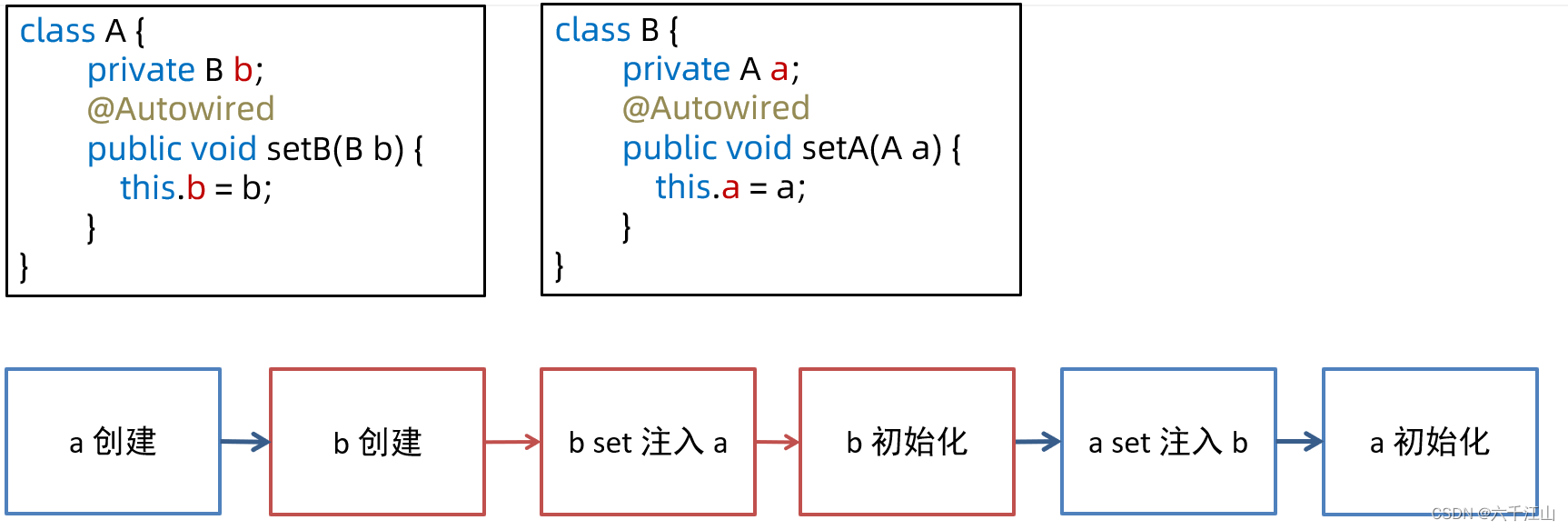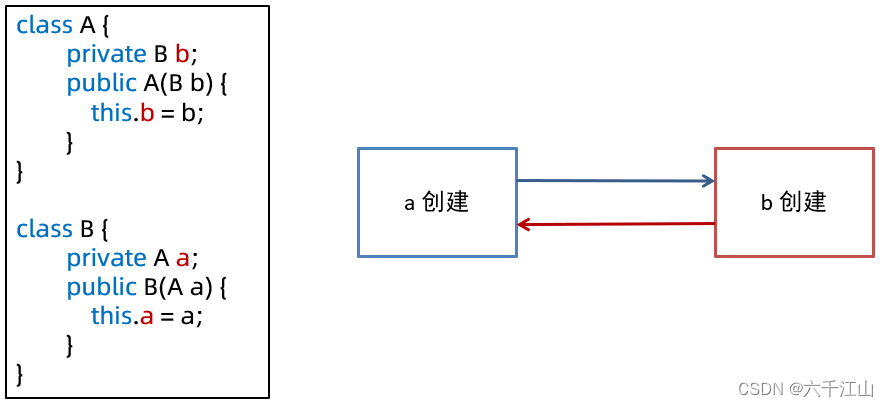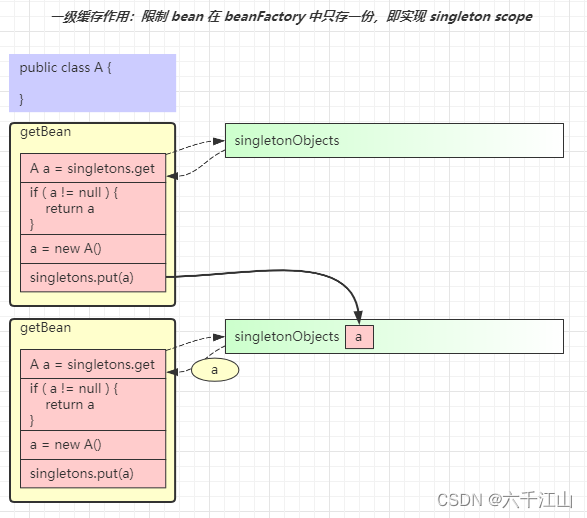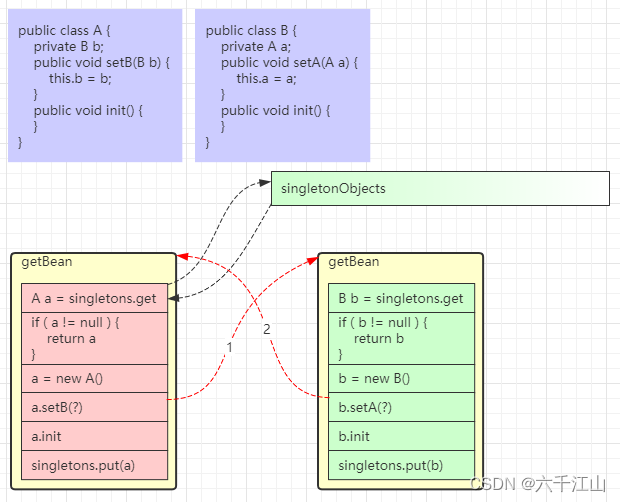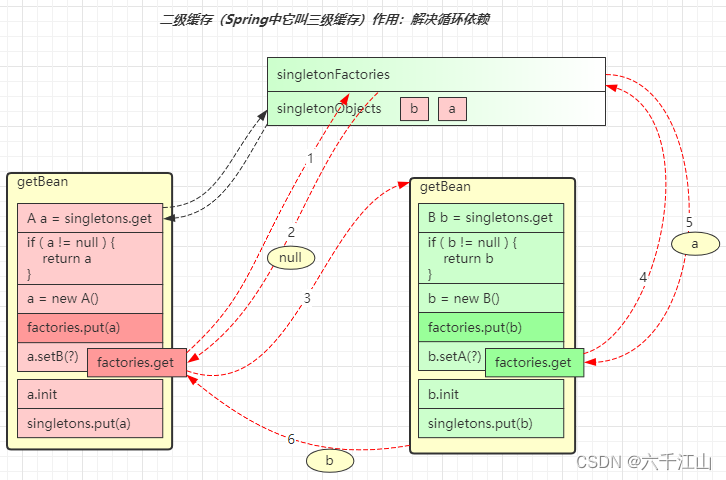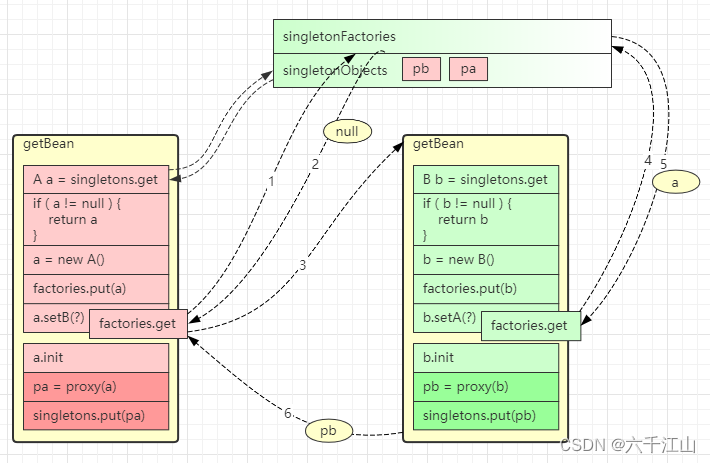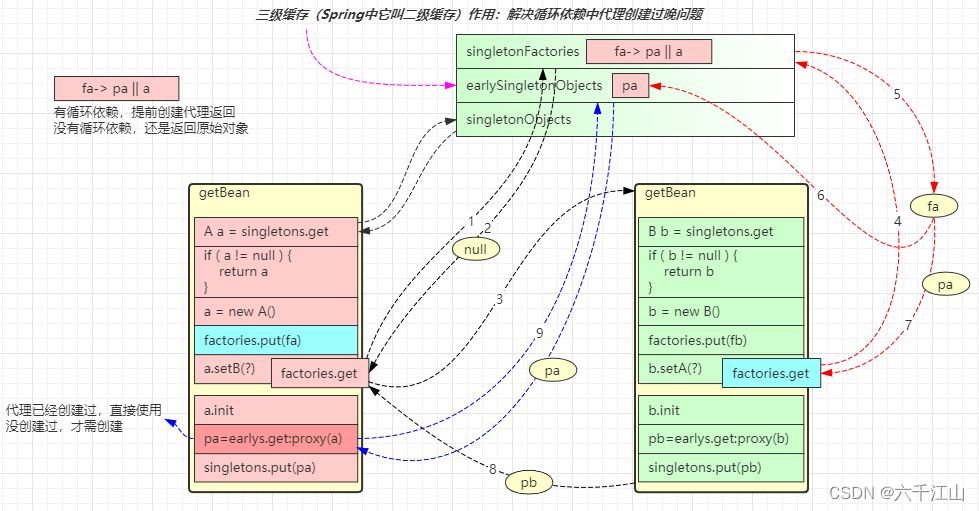循环依赖的产生
首先要明白,bean 的创建要遵循一定的步骤,必须是创建、注入、初始化三步,这些顺序不能乱
* set 方法(包括成员变量)的循环依赖如图所示
* 可以在【a 创建】和【a set 注入 b】之间加入 b 的整个流程来解决
* 【b set 注入 a】 时可以成功,因为之前 a 的实例已经创建完毕
* a 的顺序,及 b 的顺序都能得到保障
构造方法的循环依赖如图所示,显然无法用前面的方法解决
构造循环依赖的解决
* 思路1
* a 注入 b 的代理对象,这样能够保证 a 的流程走通
* 后续需要用到 b 的真实对象时,可以通过代理间接访问

* a 注入 b 的工厂对象,让 b 的实例创建被推迟,这样能够保证 a 的流程先走通
* 后续需要用到 b 的真实对象时,再通过 ObjectFactory 工厂间接访问
示例1:用 @Lazy 为构造方法参数生成代理
public class App60_1 {
static class A {
private static final Logger log = LoggerFactory.getLogger("A");
private B b;
public A(@Lazy B b) {
log.debug("A(B b) {}", b.getClass());
this.b = b;
}
@PostConstruct
public void init() {
log.debug("init()");
}
}
static class B {
private static final Logger log = LoggerFactory.getLogger("B");
private A a;
public B(A a) {
log.debug("B({})", a);
this.a = a;
}
@PostConstruct
public void init() {
log.debug("init()");
}
}
public static void main(String[] args) {
GenericApplicationContext context = new GenericApplicationContext();
context.registerBean("a", A.class);
context.registerBean("b", B.class);
AnnotationConfigUtils.registerAnnotationConfigProcessors(context.getDefaultListableBeanFactory());
context.refresh();
System.out.println();
}
}示例2:用 ObjectProvider 延迟依赖对象的创建
public class App60_2 {
static class A {
private static final Logger log = LoggerFactory.getLogger("A");
private ObjectProvider<B> b;
public A(ObjectProvider<B> b) {
log.debug("A({})", b);
this.b = b;
}
@PostConstruct
public void init() {
log.debug("init()");
}
}
static class B {
private static final Logger log = LoggerFactory.getLogger("B");
private A a;
public B(A a) {
log.debug("B({})", a);
this.a = a;
}
@PostConstruct
public void init() {
log.debug("init()");
}
}
public static void main(String[] args) {
GenericApplicationContext context = new GenericApplicationContext();
context.registerBean("a", A.class);
context.registerBean("b", B.class);
AnnotationConfigUtils.registerAnnotationConfigProcessors(context.getDefaultListableBeanFactory());
context.refresh();
System.out.println(context.getBean(A.class).b.getObject());
System.out.println(context.getBean(B.class));
}
}示例3:用 @Scope 产生代理
public class App60_3 {
public static void main(String[] args) {
GenericApplicationContext context = new GenericApplicationContext();
ClassPathBeanDefinitionScanner scanner = new ClassPathBeanDefinitionScanner(context.getDefaultListableBeanFactory());
scanner.scan("com.itheima.app60.sub");
context.refresh();
System.out.println();
}
}@Component
class A {
private static final Logger log = LoggerFactory.getLogger("A");
private B b;
public A(B b) {
log.debug("A(B b) {}", b.getClass());
this.b = b;
}
@PostConstruct
public void init() {
log.debug("init()");
}
}@Scope(proxyMode = ScopedProxyMode.TARGET_CLASS)
@Component
class B {
private static final Logger log = LoggerFactory.getLogger("B");
private A a;
public B(A a) {
log.debug("B({})", a);
this.a = a;
}
@PostConstruct
public void init() {
log.debug("init()");
}
}示例4:用 Provider 接口解决,原理上与 ObjectProvider 一样,Provider 接口是独立的 jar 包,需要加入依赖
<dependency>
<groupId>javax.inject</groupId>
<artifactId>javax.inject</artifactId>
<version>1</version>
</dependency>public class App60_4 {
static class A {
private static final Logger log = LoggerFactory.getLogger("A");
private Provider<B> b;
public A(Provider<B> b) {
log.debug("A({}})", b);
this.b = b;
}
@PostConstruct
public void init() {
log.debug("init()");
}
}
static class B {
private static final Logger log = LoggerFactory.getLogger("B");
private A a;
public B(A a) {
log.debug("B({}})", a);
this.a = a;
}
@PostConstruct
public void init() {
log.debug("init()");
}
}
public static void main(String[] args) {
GenericApplicationContext context = new GenericApplicationContext();
context.registerBean("a", A.class);
context.registerBean("b", B.class);
AnnotationConfigUtils.registerAnnotationConfigProcessors(context.getDefaultListableBeanFactory());
context.refresh();
System.out.println(context.getBean(A.class).b.get());
System.out.println(context.getBean(B.class));
}
}解决 set 循环依赖的原理
一级缓存
作用是保证单例对象仅被创建一次
* 第一次走 `getBean("a")` 流程后,最后会将成品 a 放入 singletonObjects 一级缓存
* 后续再走 `getBean("a")` 流程时,先从一级缓存中找,这时已经有成品 a,就无需再次创建
一级缓存与循环依赖
一级缓存无法解决循环依赖问题,分析如下
* 无论是获取 bean a 还是获取 bean b,走的方法都是同一个 getBean 方法,假设先走 `getBean("a")`
* 当 a 的实例对象创建,接下来执行 `a.setB()` 时,需要走 `getBean("b")` 流程,红色箭头 1
* 当 b 的实例对象创建,接下来执行 `b.setA()` 时,又回到了 `getBean("a")` 的流程,红色箭头 2
* 但此时 singletonObjects 一级缓存内没有成品的 a,陷入了死循环
二级缓存
解决思路如下:
* 再增加一个 singletonFactories 缓存
* 在依赖注入前,即 `a.setB()` 以及 `b.setA()` 将 a 及 b 的半成品对象(未完成依赖注入和初始化)放入此缓存
* 执行依赖注入时,先看看 singletonFactories 缓存中是否有半成品的对象,如果有拿来注入,顺利走完流程
对于上面的图
* `a = new A()` 执行之后就会把这个半成品的 a 放入 singletonFactories 缓存,即 `factories.put(a)`
* 接下来执行 `a.setB()`,走入 `getBean("b")` 流程,红色箭头 3
* 这回再执行到 `b.setA()` 时,需要一个 a 对象,有没有呢?有!
* `factories.get()` 在 singletonFactories 缓存中就可以找到,红色箭头 4 和 5
* b 的流程能够顺利走完,将 b 成品放入 singletonObject 一级缓存,返回到 a 的依赖注入流程,红色箭头 6
二级缓存与创建代理
二级缓存无法正确处理循环依赖并且包含有代理创建的场景,分析如下
* spring 默认要求,在 `a.init` 完成之后才能创建代理 `pa = proxy(a)`
* 由于 a 的代理创建时机靠后,在执行 `factories.put(a)` 向 singletonFactories 中放入的还是原始对象
* 接下来箭头 3、4、5 这几步 b 对象拿到和注入的都是原始对象
三级缓存
简单分析的话,只需要将代理的创建时机放在依赖注入之前即可,但 spring 仍然希望代理的创建时机在 init 之后,只有出现循环依赖时,才会将代理的创建时机提前。所以解决思路稍显复杂:
* 图中 `factories.put(fa)` 放入的既不是原始对象,也不是代理对象而是工厂对象 fa
* 当检查出发生循环依赖时,fa 的产品就是代理 pa,没有发生循环依赖,fa 的产品是原始对象 a
* 假设出现了循环依赖,拿到了 singletonFactories 中的工厂对象,通过在依赖注入前获得了 pa,红色箭头 5
* 这回 `b.setA()` 注入的就是代理对象,保证了正确性,红色箭头 7
* 还需要把 pa 存入新加的 earlySingletonObjects 缓存,红色箭头 6
* `a.init` 完成后,无需二次创建代理,从哪儿找到 pa 呢?earlySingletonObjects 已经缓存,蓝色箭头 9
当成品对象产生,放入 singletonObject 后,singletonFactories 和 earlySingletonObjects 就中的对象就没有用处,清除即可

